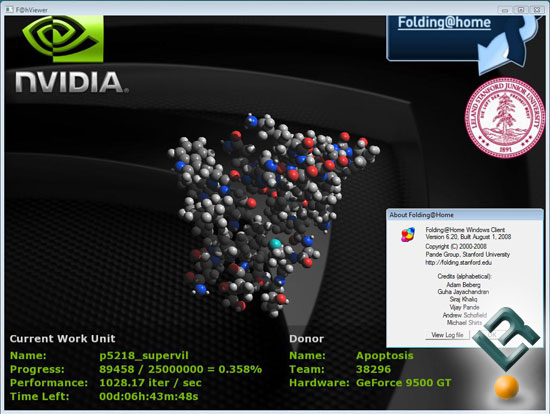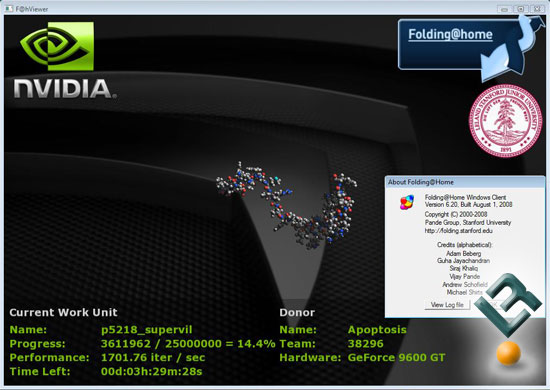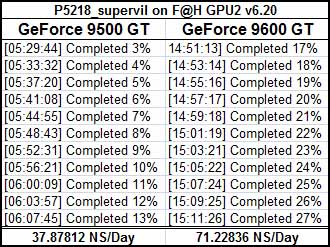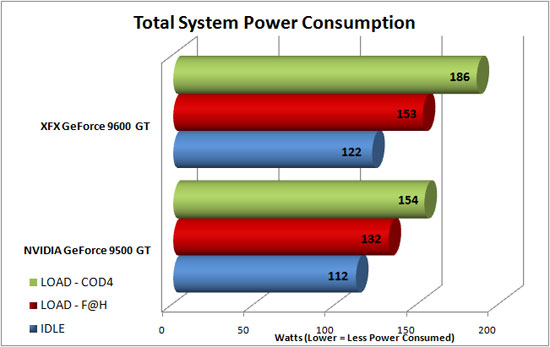NVIDIA GeForce 9500 GT Video Card Preview
Folding @ Home
Folding@Home, the distributed-computing protein-folding application from Stanford University, runs more than 100 faster on the GPU than on the fastest CPU! We tried out F@H with the just released GPU2 client version 6.20 to see how the new GeForce 9500 GT does on the latest client and public video card drivers. This version just came out on August 1st, 2008 and features a number of improvements over previous versions that are all now expired.

Folding on NVIDIA graphics cards have come a long way from when I first saw the demo working and while it is still not 100% stable (my personal system still gets driver crashes while folding) it seems to be getting close. NVIDIA has 70 million graphics cards on the market today that can run this folding client, which means that the folding project could get a huge boost in performance if more end users would join the project. To see if your video card supports CUDA, check out this list of supporting cards. If your card supports CUDA then you can try out protein folding and if you like join our folding team under 38296.

The client comes with a viewer will display a current Nanoseconds/Day performance rate (number of Nanoseconds simulated on a per-day basis) and is shown above. Why nanoseconds? Protein folding is measured in nanoseconds per day, or how many nanoseconds of the proteins life can be simulated in a days worth of computing time. The Viewer, due in part to its current requirement of moving data off and back to the GPU to render, reduces folding performance. Performance can best be measured after closing the Viewer for a little while and reading the log file. We did that on the XFX GeForce 9600 GT and the NVIDIA GeForce 9500 GT to see what the folding performance difference is.

- XFX GeForce 9600 GT (650MHz Core/1.8GHz Memory) – 71.23 NS/Day
- NVIDIA GeForce 9500 GT (600MHz Core/2.0GHz Memory) – 37.88 NS/Day
The GeForce 9500 GT and GeForce 9600 GT were both running Forceware 177.79 video card drivers and were working on the same work unit. The GeForce 9600 GT was found to be 88% faster when it comes to folding performance, which is a significant amount as you can see in the chart above if you are interested in the time it takes to complete a step. The reason for this difference is because the GeForce 9500 GT only has 32 stream processors running at 1,500MHz and the GeForce 9600 GT has 64 stream processors operating at a faster 1,625MHz. The GeForce 9500 GT is still going to improve protein folding performance over CPU folding, so if you get one of these cards be sure to download the GPU2 client and try it out for yourself.
One other thing I noticed when testing F@H was that power consumption was actually lower than when gaming! I didn’t expect this, so I made a quick chart to show the power differences between the two cards.

As you can see running F@H uses roughly 20W more power on each card, but it’s 20-30W less than playing a video game like Call of Duty 4. I thought these numbers were interesting as folding doesn’t require much more power on these cards than sitting at idle. Not only does the GPU beat the CPU in terms of folding performance it also seems to be very efficient.

Comments are closed.